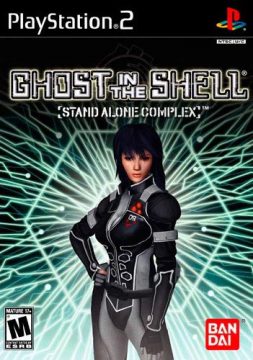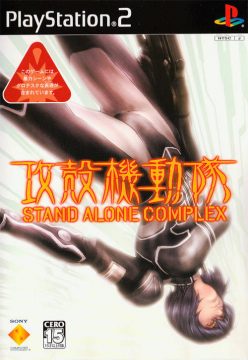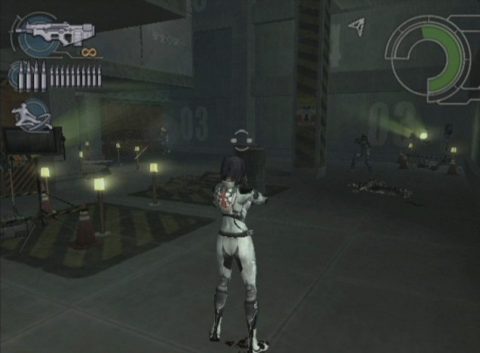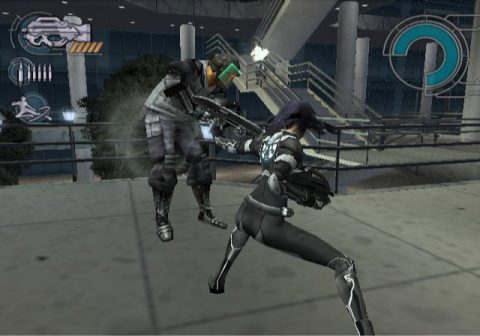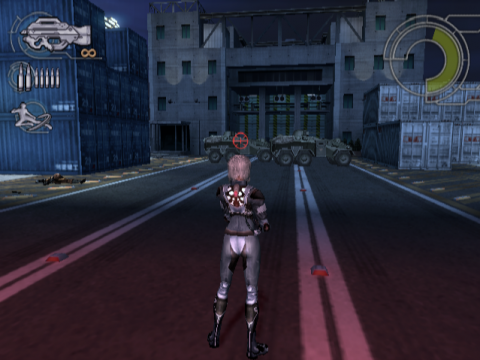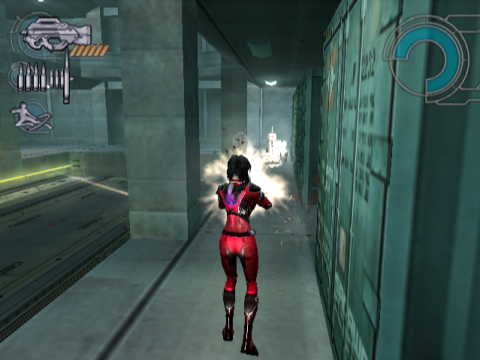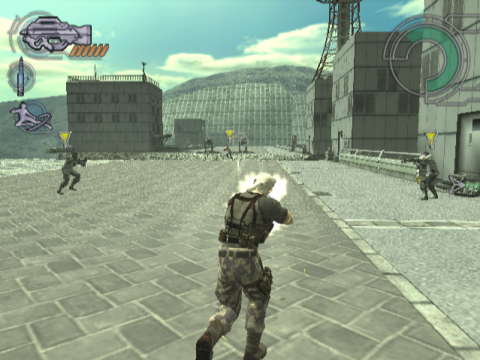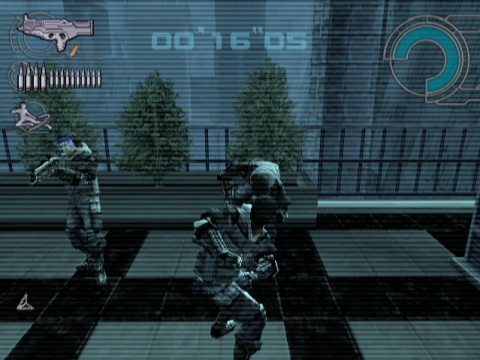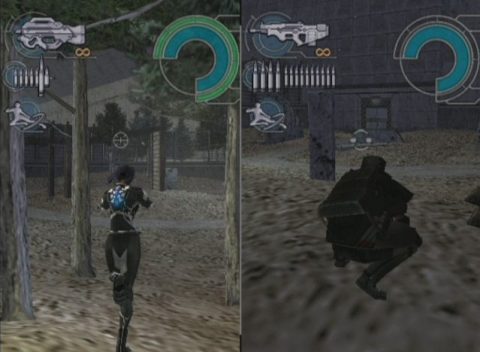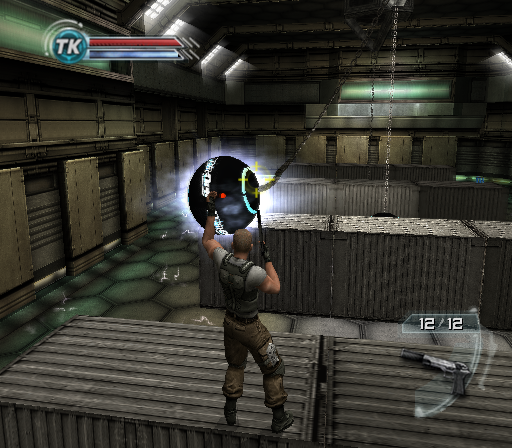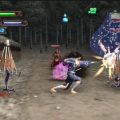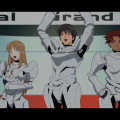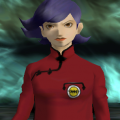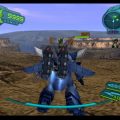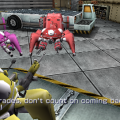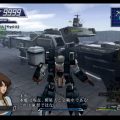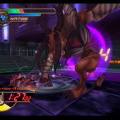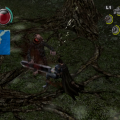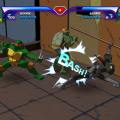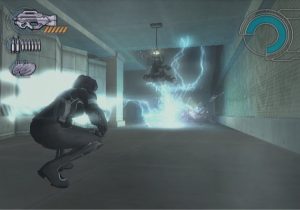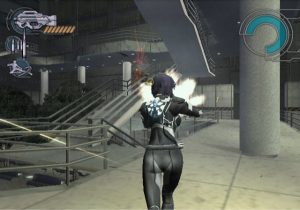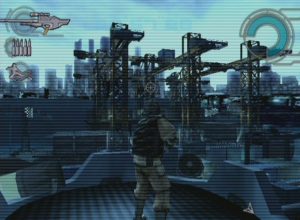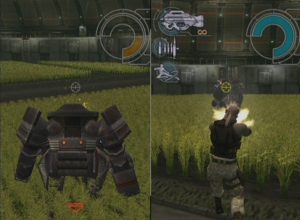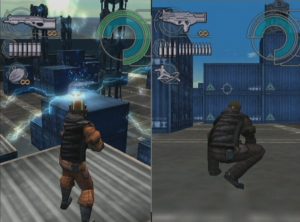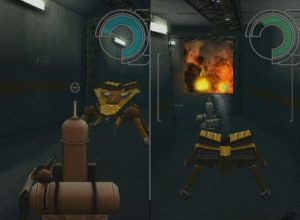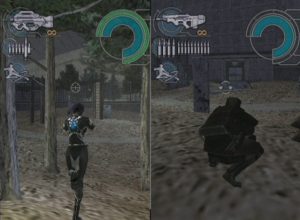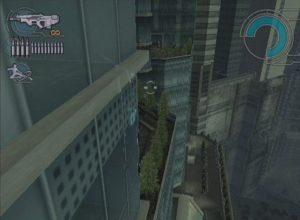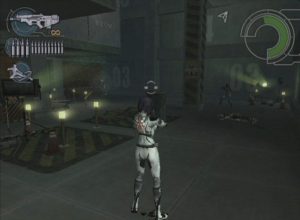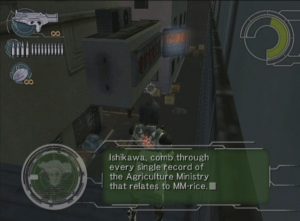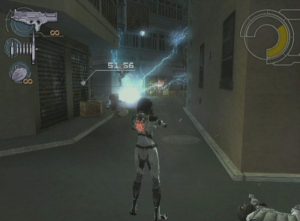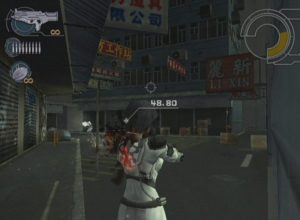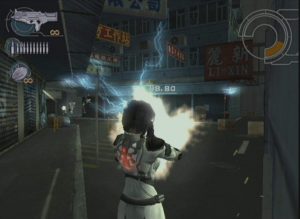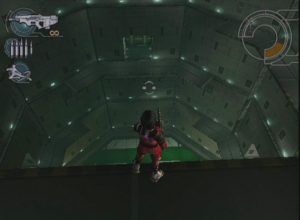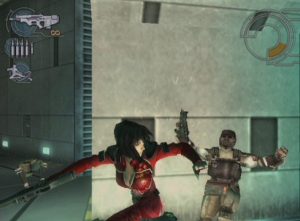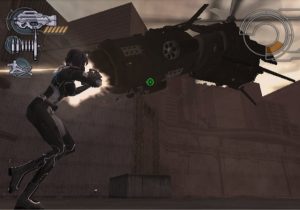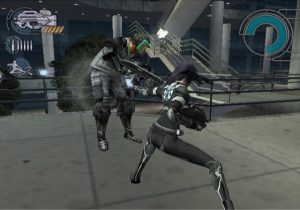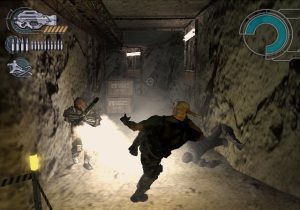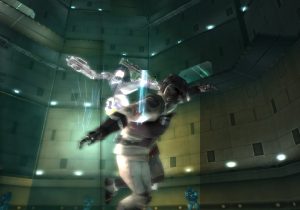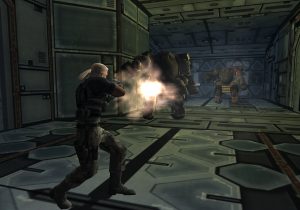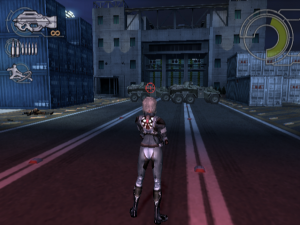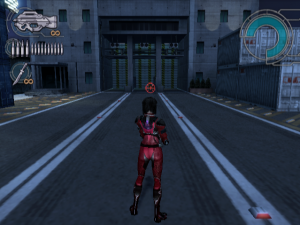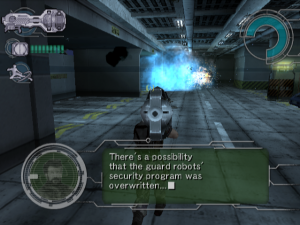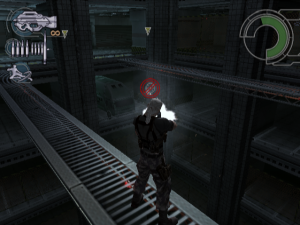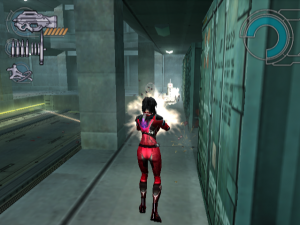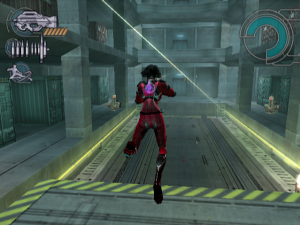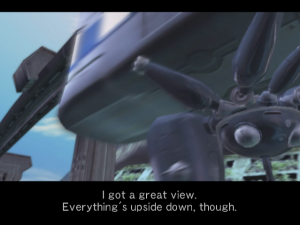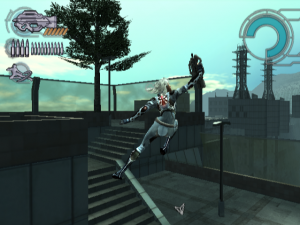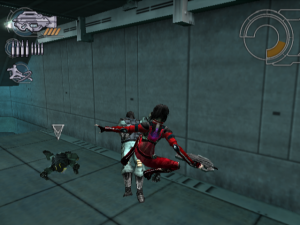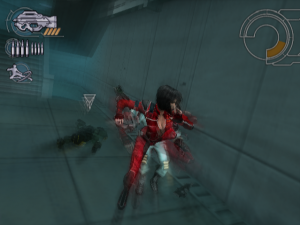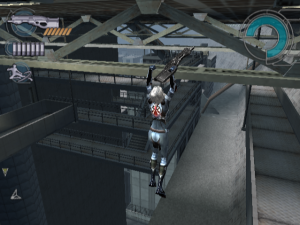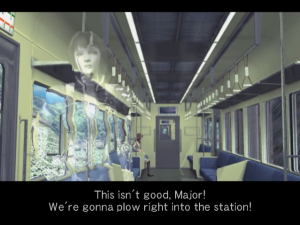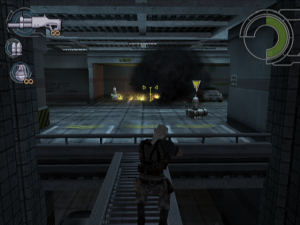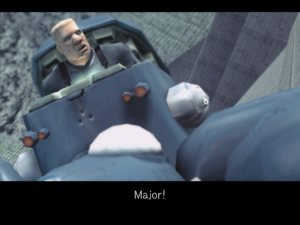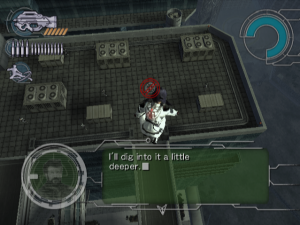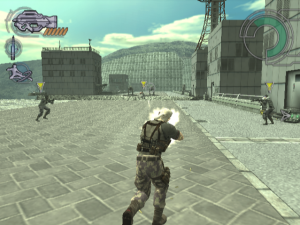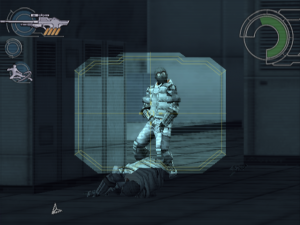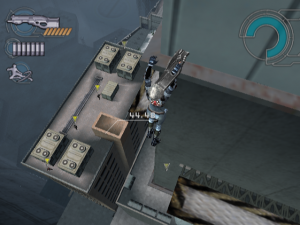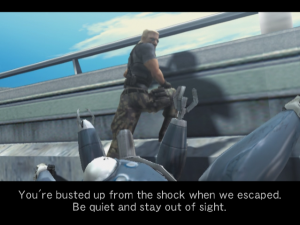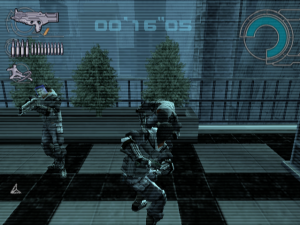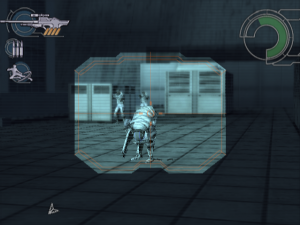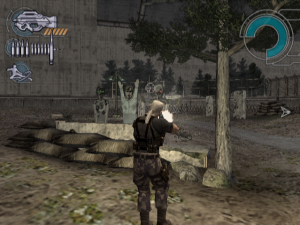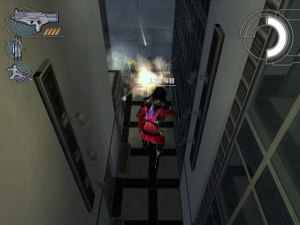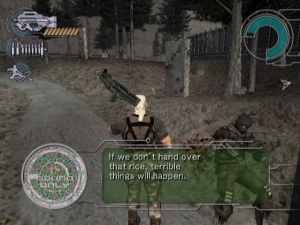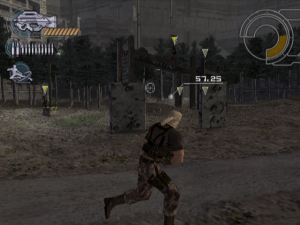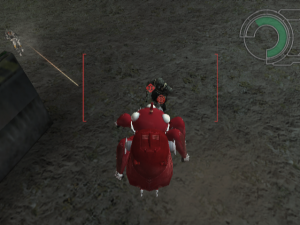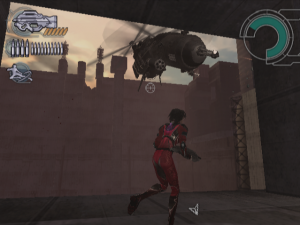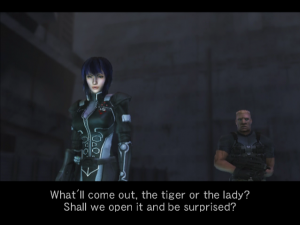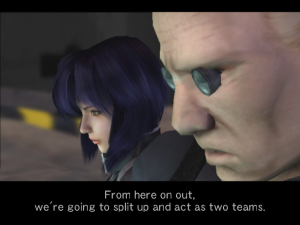For the second game development was handed over to Cavia, which previously had worked on Drakengard and Resident Evil: Dead Aim. Not the most notable of titles to secure an expensive license, but Cavia did a fine job, arguably crafting one of their best works after Nier. The first thing you’ll notice though is that it’s nothing like the previous game on the PS1. The PS2 game, much like the SAC series, represents a schism from the original manga, first film and PS1 adaptation. It’s a parallel franchise, akin to Final Fantasy proper versus Crystal Chronicles perhaps.Bullet Witch, also by Cavia, has strong similarities to GitS: SAC, especially since in interviews it was revealed the same team worked on it. SAC however, despite coming out earlier, is a far more ambitious game than Bullet Witch ever attempted to be. It’s actually comparable to the Tomb Raider platformers in many ways. Even if you didn’t enjoy Lara Croft’s outings, there’s still a lot to recommend SAC on PS2. Critics at the time may have failed to appreciate it, but as you’ll see, it’s actually one of the system’s better 3rd person action-platformers.
Imagine basically the Tomb Raider series except with its caves, jungles and ruins replaced by cyberpunk-themed cityscapes and military installations; the bears and dinosaurs substituted with robots and terrorists carrying hi-tech weapons. Dress the entire thing up in the world of Stand Alone Complex, with an excellent story scripted by those responsible for the TV series and some well balanced stealth. Tighten the character controls and the camera on the right stick, and make the female lead character even more acrobatic, able to scale impossible heights through continuous wall jumping, while clinging and climbing from every urban outcrop. This is a simplified description of SAC– at least when controlling Major Kusanagi. That’s the other change from the previous game: in addition to Kusanagi, you alternately control Batou during some levels. Of the 12 available missions seven feature Kusanagi and five Batou, though in one of Batou’s levels he’s actually inside a Tachikoma, participating in an arena fight vaguely reminiscent of the Fuchikoma on PS1.
Perhaps the Lara Croft comparison is overstated though. Along with acrobatic somersaults and climbing, there’s a strong focus on stealth. It’s extremely well integrated, though not essential to success. You can take out enemies covertly, using melee attacks or throwing knives but, if you mess up, the “all guns” approach works well too. There’s plenty of weapons at your disposal: three types of machinegun, a shotgun, sniper rifle and grenade launcher are available to both characters, while Batou has unique access to some especially high powered rockets and missiles. These are needed for taking down some of the larger mechanical bosses. The implication is that he’s of a stronger build to carry them – which is odd given that Major Kusanagi is a cyborg with enhanced strength in the series. There’s 11 main weapons in total and you can carry up to two at a time. For secondary attacks, along with melee and throwing knives, there are explosive and EMP grenades. Kusanagi can also find “stun” gear, which electrifies her melee attacks. Rounding this out is health restoratives, extra armour, and optic camouflage. By the far the most exciting power-up, it allows you to hunt down enemies while invisible, Predator-style, with them wholly unable to fight back.
Some critics have said the level design is poor and the action formulaic, but this is far from true. Perhaps it is when playing with Batou, since his levels play like any generic run-and-gun. You shoot, roll, run, and shoot some more. While it’s possible to duck, you can’t stick to cover, leaving Batou as something of an uninteresting tank. But controlling Kusanagi the game is tremendous fun, and it’s quite clear everything was designed with her in mind. Most of her stages are quite vertical, with an emphasis placed on scaling and descending heights, with exploration rewarded through optic camo pick-ups, hidden sniper rifles and – during a second playthrough – hidden paper fans which when shot will unlock bonus weapons. There’s an excellent moment midway through the game where you find some optic camo and then need to scale some balconies and move around the side of a building. At the end of the balcony you can rappel, while invisible, to a new area. There’s snipers here which will kill you in one shot, but there’s a second camo pack behind some benches, allowing you to stay hidden. You can basically run through this area. But, if you’re hunting for paper fans on a second playthrough, you might wall jump up to the balconies above you. Here there’s a sleeping guard with sniper rifle, and a paper fan. Once the guard is dead and his rifle taken, you can give the enemy a taste of its own medicine, comfortably sniping them from the same balcony they were using to attack you. Every stage is filled with little moments like these. Anyone complaining the game is formulaic isn’t using the tools available to them.
This doesn’t even touch upon the best part of SAC on the PS2: the brain hacking. This is the ability to obtain ID codes and “hacking keys” from dead enemies, allowing you to hack into the brains of other enemies from afar and control them. Actually, there’s a scenario in the first level involving both snipers and brain hacking, and it must go down as one of the greatest, most well conceived, most exciting set-pieces in video game history. After battling through several lengthy sections you reach a maze of packing crates with three snipers perched on tall towers, just out of range. As you enter the area their laser sights focus on you – once a sniper’s laser appears, you have between 2 and 3 seconds to take cover otherwise you die. One shot and it’s game over. So what do you do? Running behind some nearby crates you’re safe, and the rest of your team will radio in explaining how the snipers are using fancy German rifles. After a moment one of them suggests that one of the ground enemies might have a hacking key. Sure enough, as they move in on your presence, one will have an ID code which shows all enemies in the area as little yellow triangles, and he’ll also have a hacking key. The ID codes alone are an ingenious element, not only fitting in with the cybernetic theme of the source material, but conveying essential information (enemy positions) to the player without need for a radar. With a hacking key though you can move your aiming reticule to specific triangles that flash blue, then push X to initiate a hack.
Hacking an enemy involves playing through a little minigame involving two spinning circles. When the teeth and gaps line up, like a key in a computer lock, you hit X again to complete the hack. Some enemies require you do this up to three times. Fail and you can immediately retry once you’re warped back to the game world, without penalty, so it’s quite easy. After hacking you’re presented with an enemy viewpoint in a blue-toned CCTV style, and a time limit of around 60 seconds. Movement is a little jerky and robotic, as you’d expect, but now you can control and make use of all his weapons. So after hacking one of the snipers you can use him to take out the other two on the towers, who are entirely oblivious to their comrade’s plight, plus take out a few generic enemies on the adjacent roof, before making your marionette jump to his doom, thereby allowing you to collect the rifle for yourself. It cannot be overstated how awesome this sequence is, whereby the most deadly enemy in the game becomes merely another one of your tools.
Describing it in these plain terms could make it sound forced, and while the scenario was undoubtedly scripted in a way to encourage players to do all of the above, it’s implemented seamlessly into gameplay. It feels less like a traditional game, such as with the PS1 version, and more like you are in direct control of the anime, able to do as the characters would do. There’s no loading, no cut-scene, no annoying tutorial box and no onscreen pointers telling you what to do or where to do it. In fact, the only clues are what’s printed in the manual regarding hacking and a brief, subtle radio message from your team. It’s very easy in fact to miss this message entirely if you’re not paying attention! It’s almost as if the developer trusts that the player isn’t an idiot and can work things out on their own – which is in stark contrast to today. You can also fail this scenario, for example by only wounding one of the snipers and turning your attention away from him, thereby allowing him to retaliate. You’re only given one hacking key, so if you waste it, you’re forced to skulk between the containers avoiding the enemy’s gaze.
The storyline tying all of this together is also fantastic. A lot of GitS fans ask about the PS2 and PSP games, voicing a curiosity in trying them, though only for the story. If you have an interest in the animation, then the games – especially the PS2 release – are absolutely worth your time. The cinemas may be hideous polygonal CG, rather than traditional animation, but the voice work uses the same actors and the plot is canonical. Or at least it’s by Production IG, so feels authentic. What starts as a routine counter-terrorist operation, and leads to some seemingly innocuous rice, builds into a far-reaching and dangerous scheme. As you’d expect from the franchise there’s plenty of philosophical debate amidst the gunplay, and the “bad guys” aren’t exactly unambivalently evil, even if their methods appear to be. There’s also a good twist every couple of missions or so. Also since Kusanagi and Batou alternate in control while their actions take place almost concurrently, you’re able to see the story evolve from different angles. It’s not quite the same as two sub-plots intersecting in the animated series, since the scenes can cut from one to another, whereas with the game you need to complete an entire mission first, but it’s still a clever set-up in terms of narrative.
Overall SAC has quite a mature story, not in the blood-and-tits way described by various age rating systems, but in the themes and ideas it puts across. Given the current hostility within the games industry from various copyright and patent trolls, the similar situations found in-game which relate to food production should resonate and prove rather poignant. For light relief there’s also the Tachikoma, which are as endearing as always, though perhaps without as noticeable a presence as the follow-up PSP game. The game is also quite easy on the lowest difficulty, so those only interested in the story should be able to reach the end. Additionally, for those who find the films and series a little too fast moving, the PS2 game has an always accessible word glossary, which updates as new subjects come up, and gives detailed background information on everything. It’s like having your own Ghost in the Shell Wiki on-hand at any moment.
Despite the high quality of everything, and some astoundingly well implemented ideas, SAC suffers from more acute problems than its predecessor. Firstly it’s also too short: according to in-game timer for each stage, you’re looking at roughly 4 hours play time on Normal difficulty. There’s some encouragement to replay the game, since after finishing it once you unlock new costumes, optional infinite ammo, and the ability to choose an extra weapon before each mission. The hidden paper fans also only appear on the second playthrough – there’s 120 in total in the Western version (versus 36 in the Japanese), and if you shoot them all you unlock more weapons. Unfortunately it’s rather tedious searching for them. Even more weapons can be unlocked by completing every mission individually without dying. Still, this all requires playing through levels you’ve already seen, and here’s the other problem: they’re all too long. The game is short, but it’s broken up into uncomfortably long missions. The first, taking place at the docks, will take you over 30 minutes before you can save. Even replaying it, knowing where to go, the time will be around 20 minutes. There’s checkpoints if you die, which eases things a bit, but you’re only going to make progress in the game if you set aside at minimum half an hour’s playtime. Being forced to replay these lengthy segments without dying, just to unlock some trinkets, gets annoying fast.
There are 10 difficulty levels (Easy, Normal, Hard, Very Hard, Aggressive, Dangerous, Execution, Hopeless, Nightmare and Champion), but all of them are utterly pointless. Unlocking those above Hard requires you attain a specific overall score. For example Very Hard is unlocked by attaining a total of 15,000 points or more over all the levels. The higher the difficulty you tackle a level on, the bigger your score multiplier. Playing through harder difficulties does nothing other than unlock even more difficulty levels. It’s an exercise in pure tedium. All of the bonus weapons and extra characters for multiplayer are unlocked through completing the three standard difficulties, meaning there’s zero point to the others. The seven extra levels above Hard were actually introduced during localization, according to Roy Brewer. You can also thank the localization team for botching the game’s balance, since they upped the hidden paper fan count from 3 per level to 10, turning a simple treasure hunt into an arduous chore. As Brewer explains: “For example, we had the number of difficulties increased so there are ten settings instead of three. We also had the number of items the player had to find to unlock things increased from three per stage to ten per stage. With these changes we know the title will challenge the U.S. gamers.”
The act of increasing the difficulty between regions is an insidious one that dates back to the NES era, and it really needs to stop. There’s little gameplay difference between the three standard difficulties, just the usual increase/decrease of damage and health variables. The new higher difficulties, introduced for the US, meanwhile only make things harder in arbitrary and cheap ways – simply dumping more and bigger enemies in your path. If you’re inclined towards tackling such challenges, then fair enough, but it ruins some otherwise well paced encounters and makes a mockery of the stage design. Take the opening area for example, which starts with just Kusanagi and a sleeping guard. On Execution difficulty there’s two tanks in the way, which doesn’t make the game any more fun, it’s just annoying. Everyone is recommended to play through on Normal and be done with it.
Then there’s the AI, which certainly isn’t “bad” but is perhaps a little slow. A lot of reviewers complain about “bad AI” but without articulating why. AI can be bad if the enemy ignores the player entirely, and likewise it is bad if enemies move in on a player’s position even if they’ve done nothing to make their presence known. When coding a game the “program” which facilitates play knows where everything is at all times – there’s a list of numerical variables which it is constantly aware of. It would be illogical for a program to not be omnipotent. The difficulty therefore is simulating the impression that enemies within an environment are not fully aware of the player, even though they blatantly are. In SAC the enemies will follow a predetermined route until you make your presence known, after which they will move in a pattern looking for you. Some will hold position while others investigate different areas. If you’re in their line of sight they will attack. If there is a criticism, it’s that the AI is slow when searching for the player. It will, however, produce some interesting behavior from time to time.
A good place to test the AI is the slum area, midway through the game. It’s a circular maze with good opportunities to trick the enemies patrolling the area. They’ll react quickly to noise and gunfire, and a couple will try to work their way around the outside to end up behind you. The problem is most players move quickly, making the AI seem stupid in comparison. In fact it’s possible to run right through this area (most areas in fact) with the enemy reaction being slow enough to make it past. When using optic camo they’re even slower – some will fire randomly in fright, which really adds to the atmosphere, but the reaction isn’t quick enough. They should be firing all over the place. Likewise if you’re controlling the enemy. While they will attack their own if possessed, by the time they do so you’ve probably wiped most of them out.
Also as mentioned, the CG cinemas really are hideous, some of the worst you’ll find, and it’s a shame that Production IG didn’t use cel-animation like with the PS1 game. It actually detracts slightly from what is a genuinely excellent story and top notch voice work. Batou resembles a pig even more than usual, while Kusanagi appears like a plastic mannequin. Admittedly she’s a cyborg and therefore her body is synthetic, but she’s gone from being attractive in the manga and TV series to looking downright creepy here.
None of these problems are game breakers though. Perhaps the AI is too easy in places, and maybe that first level is a bit longer than it should be, but none of the criticisms raised are reason not to play the game. Especially given the low prices it goes for. Truthfully, the most severe criticism you can raise against SAC is that it never capitalizes on its strengths. Brain hacking is amazing, from the basic concept through to its slick execution and sublime range of possibilities. But it’s painfully underused. Throughout the game’s 12 missions, there are maybe 12 or so instances when you can use it. Which is madness. It’s so good that you could scrap the gunplay entirely and build a whole game around the concept of hacking enemies. In fact some developers have done just that. So why is it used so sparingly here? A better option would have been to grant two or three hacking keys at the start of every mission, and allowed players to use them on any enemy at any time, not just a specific few. Another missed opportunity is the single Tachikoma level, which is alright to play, but doesn’t come close to previous PS1 game. You can’t climb on walls, the weapons are too limited, and it just feels a bit stodgy to control. There’s also only one section where you use the Tachikoma, despite the main characters riding them during several cut-scenes. Why did Cavia go to all the trouble of programming a distinct physics engine and character models, only to make use of them in a single 10 minute area? With a little polish to the physics, it could have made an excellent addition and warranted several extra stages.
Nearly a decade later and SAC for the PS2 seems forgotten in light of other, flashier action games. But with hindsight it’s still supremely playable. Whatever your thoughts on its negative aspects, the controls at least feel as tight and responsive as any modern game, while the story and the brain hacking keep it interesting. Sadly it’s impossible to emulate correctly – for the moment anyway. When tested with PCSX2 1.0.0 (r5350), the first gate, roughly 20 seconds into the first level, is impossible to open. The emulator simply does not register the action. You can download a save and bypass the first level (and that awesome sniper section), but later stages have the same problem. Every single mission features some kind of door or switch which needs activating, and about half of them don’t register when emulated. Meaning the only way to go is an original copy in an actual PS2. The added benefit of this over PC emulation is the multiplayer, for up to four players if you have a multitap.
Searching the internet there doesn’t seem to be any shots showing the four player option, which makes the one above something of an online exclusive. Although not tested due to lacking a multitap, there has been nothing but good things said on various forums regarding the 4P modes. You can choose either Battle Royale, which is a free for all, or Team Mode, which is self explanatory. The 2P mode also isn’t too shabby. Whichever mode you choose, you’ve got access to a variety of generic grunts to play as. Finishing the game on the lowest three difficulty modes will also unlock Kusanagi, Batou, a Tachikoma, and a few mechanical enemies, in addition to some new arenas.
Playing it split screen the action is frenetic and tremendous fun, though the arenas are perhaps not as well designed as something like Goldeneye. The framerate is obviously better, and there’s no fogging, but the combat zones tend to be flat, even when there’s something like crates to climb. Most of the areas are big squared off “rooms”, with a couple of corridor mazes, but none of them could be described as intricate in the same Goldeneye‘s Facility was. It’s also pure run-and-gun action, without anything resembling the tension of using proximity mines – a case of simply spotting another player and opening fire. After dying players respawn while cloaked, giving them a fighting chance. It’s simple and very enjoyable, adding longevity to a generally short game. Also, if you’ve got a PS2 multitap and four controllers (!!), there’s probably not many better 4P games available for the system.

